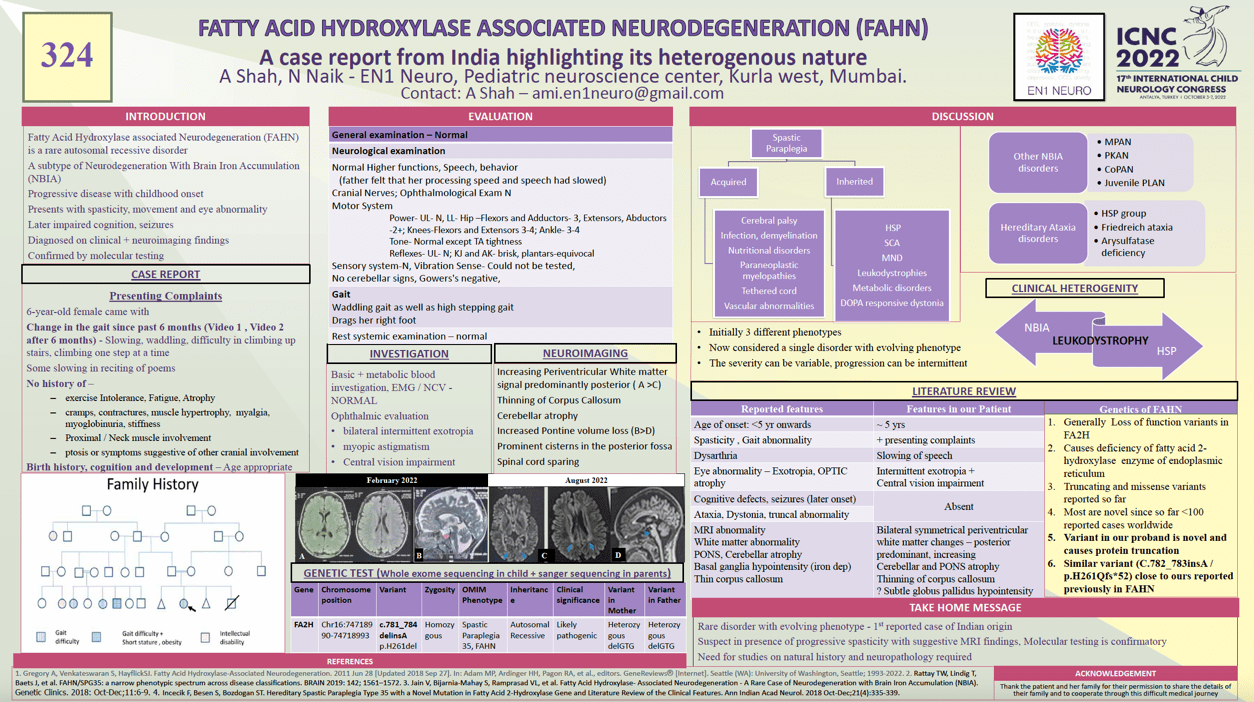Fatty Acid Hydroxylase associated Neurodegeneration (FAHN) – A case report from India highlighting its heterogenous nature.
Ami Shah, Neeta Naik
Objective: We discuss a case of childhood onset spastic paraparesis diagnosed to have Fatty Acid Hydroxylase associated Neurodegeneration (FAHN) resulting from a novel pathogenic variant in FA2H gene to highlight the phenotype - genotype heterogeneity of this rare disorder.
Introduction: FAHN is a subtype of Neurodegeneration with Brain Iron Accumulation (NBIA) which combines 2 previously described phenotypes of the FA2H gene - leukodystrophy and hereditary spastic paraplegia. The disorder has an onset in the first decade of life with gait abnormalities and later progresses to develop motor and intellectual impairment. White matter abnormalities, ponto-cerebellar atrophy, thinning of corpus callosum and hypo intensity of globus pallidus are predominant neuroimaging features.
Case Report: We present a 6-year-old girl born of 3rd degree consanguineous marriage, having normal birth and development history; with progressive slowing of gait and speech in last 6 months. She had waddling gait, symmetrical proximal and distal motor weakness in the lower limbs, ankle hypertonia and clonus. Her EMG and NCV was normal, and neuroimaging revealed bilateral periventricular white matter hyperintensities with mild cerebellar atrophy. The clinical differentials were NBIA vs Hereditary Spastic Paraplegia (HSP). Molecular analysis revealed a novel homozygous deletion in FA2H gene, segregating amongst her parents, thus confirming a diagnosis of FAHN.
Conclusions: FAHN is a rare disorder belonging to NBIA spectrum and mimic HSP. Early onset progressive paraparesis and classis MRI features help in differentiating them. Awareness of the variable phenotypic spectrum and the need for molecular diagnosis is emphasized.
Keywords: FAHN, Heriditary spastic paraplegia, FA2H gene, NBIA
Ami Shah
EN1 Neuro Services Pvt. Ltd. Mumbai.
India
Neeta Naik
EN1 Neuro Services Pvt. Ltd. Mumbai.
India
Objective: We discuss a case of childhood onset spastic paraparesis diagnosed to have Fatty Acid Hydroxylase associated Neurodegeneration (FAHN) resulting from a novel pathogenic variant in FA2H gene to highlight the phenotype - genotype heterogeneity of this rare disorder.
Introduction: FAHN is a subtype of Neurodegeneration with Brain Iron Accumulation (NBIA) which combines 2 previously described phenotypes of the FA2H gene - leukodystrophy and hereditary spastic paraplegia. The disorder has an onset in the first decade of life with gait abnormalities and later progresses to develop motor and intellectual impairment. White matter abnormalities, ponto-cerebellar atrophy, thinning of corpus callosum and hypo intensity of globus pallidus are predominant neuroimaging features.
Case Report: We present a 6-year-old girl born of 3rd degree consanguineous marriage, having normal birth and development history; with progressive slowing of gait and speech in last 6 months. She had waddling gait, symmetrical proximal and distal motor weakness in the lower limbs, ankle hypertonia and clonus. Her EMG and NCV was normal, and neuroimaging revealed bilateral periventricular white matter hyperintensities with mild cerebellar atrophy. The clinical differentials were NBIA vs Hereditary Spastic Paraplegia (HSP). Molecular analysis revealed a novel homozygous deletion in FA2H gene, segregating amongst her parents, thus confirming a diagnosis of FAHN.
Conclusions: FAHN is a rare disorder belonging to NBIA spectrum and mimic HSP. Early onset progressive paraparesis and classis MRI features help in differentiating them. Awareness of the variable phenotypic spectrum and the need for molecular diagnosis is emphasized.
Keywords: FAHN, Heriditary spastic paraplegia, FA2H gene, NBIA
Ami Shah
EN1 Neuro Services Pvt. Ltd. Mumbai.
India
Neeta Naik
EN1 Neuro Services Pvt. Ltd. Mumbai.
India
